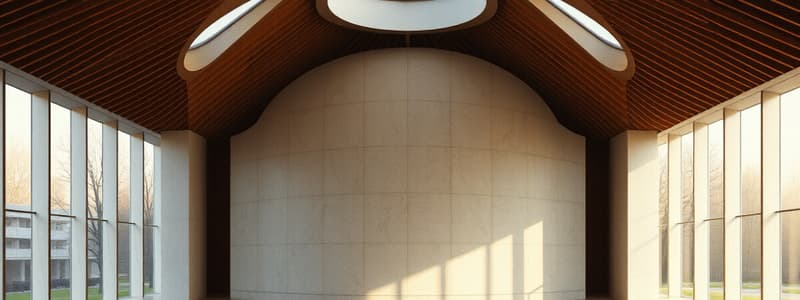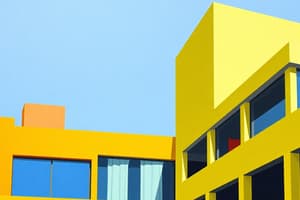Podcast
Questions and Answers
Which traditional building materials have been foundational for centuries?
Which traditional building materials have been foundational for centuries?
- Stone, brick, and wood (correct)
- Plastic and steel
- Aluminum and vinyl
- Concrete and glass
What architectural feature contrasts with the modern disdain for traditional aesthetics in Kahn's work?
What architectural feature contrasts with the modern disdain for traditional aesthetics in Kahn's work?
- Monumentality
- Minimalism
- Symmetry (correct)
- Brutalism
Which of the following materials did Kahn NOT use in his designs?
Which of the following materials did Kahn NOT use in his designs?
- Ceramics
- Marble
- Glass (correct)
- Copper
What primary characteristic does Kahn aim for in his architectural designs, such as the National Assembly in Dhaka?
What primary characteristic does Kahn aim for in his architectural designs, such as the National Assembly in Dhaka?
What structural element is exemplified by the Salk Institute in Kahn's philosophy?
What structural element is exemplified by the Salk Institute in Kahn's philosophy?
What shift in materials occurred in early 20th-century modernist architecture?
What shift in materials occurred in early 20th-century modernist architecture?
What is a characteristic feature of Louis Kahn's design philosophy?
What is a characteristic feature of Louis Kahn's design philosophy?
Which design traditionally evokes a sense of grandeur in Kahn’s architecture?
Which design traditionally evokes a sense of grandeur in Kahn’s architecture?
What type of architecture did Kahn aspire to create with his designs?
What type of architecture did Kahn aspire to create with his designs?
What type of materials does Kahn often juxtapose in his designs to create a dialogue between old and new?
What type of materials does Kahn often juxtapose in his designs to create a dialogue between old and new?
Study Notes
Traditional vs. Modern Materials
- Stone, brick, and wood have been foundational building materials for millennia, embodying charm and nobility.
- Early 20th-century modernist architecture shifted to concrete, steel, and sheet glass, often resulting in structures perceived as brutal and alienating.
- There is a call for modern architects to incorporate traditional materials while maintaining contemporary forms.
Louis Kahn's Influence
- Louis Kahn, a prominent modernist architect, was born in Russia in 1901 and immigrated to the U.S. at age three.
- His architectural studies at the University of Pennsylvania led to a significant resurgence in the late 1950s after a transformative trip to Rome.
- Kahn uniquely integrated ancient architectural elements with modernist techniques, promoting a dialogue with historical architecture.
Design Principles
- Symmetry featured significantly in Kahn's work, contrasting with the modern disdain for such traditional aesthetics.
- The Salk Institute in California exemplifies this design philosophy with symmetrical buildings flanking a central fountain.
- Kahn intended symmetry to create balance, focus, and momentum, rather than merely an aesthetic choice.
Sense of Grandeur
- Kahn's designs evoke a sense of magnificence, reminiscent of historical structures like cathedrals.
- At the Yale Centre for British Art, high ceilings draw eyes upward, mimicking the dome of religious buildings and conveying loftiness.
Material Diversity
- Kahn utilized a variety of sensory materials, actively incorporating ceramics, copper, and brick alongside modern materials like concrete.
- Juxtaposing oak with concrete juxtaposes warmth and domesticity with strength and stability, symbolizing reconciliation between old and new.
Concept of Monuments
- Kahn sought to create monumental architecture that transcends the modern rejection of authority and sentimentality in building design.
- His National Assembly in Dhaka is a prime example, merging modern aesthetics with an eternal quality echoing historic edifices.
Lasting Legacy
- Kahn's buildings embody a luxury defined by durability and timelessness, aspiring to endure for centuries.
- The Kimbell Art Museum in Texas, characterized by travertine marble, white oak, and open designs, exemplifies Kahn's aesthetic brilliance.
- Upon his death in 1974, Kahn was the most renowned architect in the U.S., continuing to influence contemporary architecture by integrating traditional elements with modernist ideals.
Traditional vs. Modern Materials
- Stone, brick, and wood are historic, essential building materials, combining aesthetic beauty with durability.
- The rise of modernist architecture in the early 20th century favored concrete, steel, and sheet glass, often criticized for their cold, stark appearance.
- A contemporary movement advocates for integrating traditional materials into modern architecture, promoting harmony between old and new styles.
Louis Kahn's Influence
- Louis Kahn, born in Russia in 1901, immigrated to the U.S. at age three and studied architecture at the University of Pennsylvania.
- His architectural approach gained prominence in the late 1950s, influenced by a transformative visit to Rome, infusing his work with classical elements.
- Kahn creatively blended ancient architectural styles with modern techniques, fostering a conversation between historical and contemporary architecture.
Design Principles
- Kahn's work prominently features symmetry, challenging the modernist trend that often dismisses traditional design principles.
- The Salk Institute in California epitomizes Kahn's principle of symmetry, with two symmetrical buildings framing a central fountain.
- Symmetry in Kahn’s designs strives for balance and focus, serving functional purposes beyond mere decoration.
Sense of Grandeur
- Kahn's architectural style conveys grandeur, echoing the majesty of historical structures like cathedrals.
- At the Yale Centre for British Art, soaring ceilings evoke the verticality of religious buildings, fostering a sense of elevation and space.
Material Diversity
- Kahn’s innovative use of materials includes ceramics, copper, and brick, alongside more conventional modern materials like concrete.
- The juxtaposition of warm oak with cold concrete symbolizes the coexistence and reconciliation of traditional and modern elements.
Concept of Monuments
- Kahn aimed to create monumental structures that defy the modern skepticism toward authority and emotional connections in architecture.
- The National Assembly in Dhaka exemplifies Kahn's vision, merging contemporary aesthetics with a timeless quality reminiscent of ancient architecture.
Lasting Legacy
- Buildings designed by Kahn are marked by a sense of luxury rooted in durability and timelessness, intended to last for generations.
- The Kimbell Art Museum in Texas showcases Kahn's distinctive style, featuring materials like travertine marble and white oak in its open design.
- By the time of his death in 1974, Kahn had established himself as the preeminent architect in the U.S., leaving a profound legacy that continues to inspire by merging traditional and modernist design principles.
Traditional vs. Modern Materials
- Stone, brick, and wood are historic, essential building materials, combining aesthetic beauty with durability.
- The rise of modernist architecture in the early 20th century favored concrete, steel, and sheet glass, often criticized for their cold, stark appearance.
- A contemporary movement advocates for integrating traditional materials into modern architecture, promoting harmony between old and new styles.
Louis Kahn's Influence
- Louis Kahn, born in Russia in 1901, immigrated to the U.S. at age three and studied architecture at the University of Pennsylvania.
- His architectural approach gained prominence in the late 1950s, influenced by a transformative visit to Rome, infusing his work with classical elements.
- Kahn creatively blended ancient architectural styles with modern techniques, fostering a conversation between historical and contemporary architecture.
Design Principles
- Kahn's work prominently features symmetry, challenging the modernist trend that often dismisses traditional design principles.
- The Salk Institute in California epitomizes Kahn's principle of symmetry, with two symmetrical buildings framing a central fountain.
- Symmetry in Kahn’s designs strives for balance and focus, serving functional purposes beyond mere decoration.
Sense of Grandeur
- Kahn's architectural style conveys grandeur, echoing the majesty of historical structures like cathedrals.
- At the Yale Centre for British Art, soaring ceilings evoke the verticality of religious buildings, fostering a sense of elevation and space.
Material Diversity
- Kahn’s innovative use of materials includes ceramics, copper, and brick, alongside more conventional modern materials like concrete.
- The juxtaposition of warm oak with cold concrete symbolizes the coexistence and reconciliation of traditional and modern elements.
Concept of Monuments
- Kahn aimed to create monumental structures that defy the modern skepticism toward authority and emotional connections in architecture.
- The National Assembly in Dhaka exemplifies Kahn's vision, merging contemporary aesthetics with a timeless quality reminiscent of ancient architecture.
Lasting Legacy
- Buildings designed by Kahn are marked by a sense of luxury rooted in durability and timelessness, intended to last for generations.
- The Kimbell Art Museum in Texas showcases Kahn's distinctive style, featuring materials like travertine marble and white oak in its open design.
- By the time of his death in 1974, Kahn had established himself as the preeminent architect in the U.S., leaving a profound legacy that continues to inspire by merging traditional and modernist design principles.
Studying That Suits You
Use AI to generate personalized quizzes and flashcards to suit your learning preferences.
Description
Explore the evolution of architectural materials from traditional to modern styles and understand the impact of prominent architect Louis Kahn. This quiz highlights Kahn's integration of classical elements in contemporary design and the principles that defined his work. Test your knowledge on how architecture has transformed over the years!





